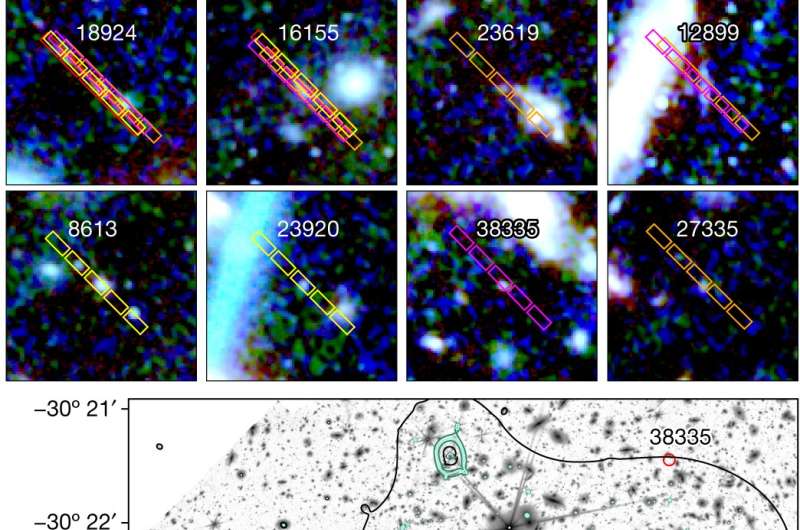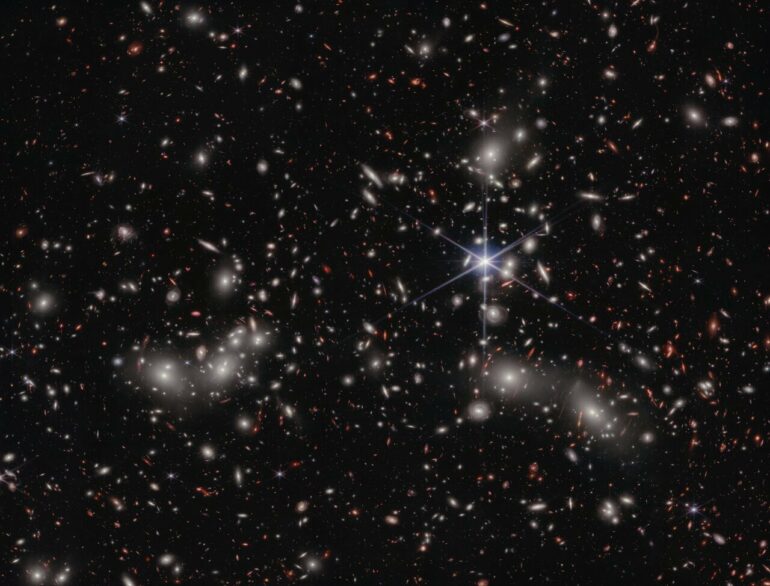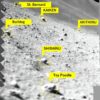Using the unprecedented capabilities of the NASA/ESA/CSA James Webb Space Telescope, an international team of scientists has obtained the first spectroscopic observations of the faintest galaxies during the first billion years of the universe. These findings, published in the journal Nature, help answer a longstanding question for astronomers: What sources caused the reionization of the universe? These new results have effectively demonstrated that small dwarf galaxies are the likely producers of prodigious amounts of energetic radiation.
Researching the evolution of the early universe is an important aspect of modern astronomy. Much remains to be understood about the time in the universe’s early history known as the era of reionization.
It was a period of darkness without any stars or galaxies, filled with a dense fog of hydrogen gas until the first stars ionized the gas around them, and light began to travel through. Astronomers have spent decades trying to identify the sources that emitted radiation powerful enough to gradually clear away this hydrogen fog that blanketed the early universe.
The Ultradeep NIRSpec and NIRCam ObserVations before the Epoch of Reionization (UNCOVER) program (#2561) consist of both imaging and spectroscopic observations of the lensing cluster Abell 2744. An international team of astronomers used gravitational lensing by this target, also known as Pandora’s Cluster, to investigate the sources of the universe’s period of reionization.
Gravitational lensing magnifies and distorts the appearance of distant galaxies, so they look very different from those in the foreground. The galaxy cluster ‘lens’ is so massive that it warps the fabric of space itself, so much so that light from distant galaxies that passes through the warped space also takes on a warped appearance.
The magnification effect allowed the team to study very distant sources of light beyond Abell 2744, revealing eight extremely faint galaxies that would otherwise be undetectable, even to Webb.
The team found that these faint galaxies are immense producers of ionizing radiation, at levels that are four times larger than what was previously assumed. This means that most of the photons that reionized the universe likely came from these dwarf galaxies.
“This discovery unveils the crucial role played by ultra-faint galaxies in the early universe’s evolution,” said team member Iryna Chemerynska of the Institut d’Astrophysique de Paris in France. “They produce ionizing photons that transform neutral hydrogen into ionized plasma during cosmic reionization. It highlights the importance of understanding low-mass galaxies in shaping the universe’s history.”

Layout of the ultra-faint galaxies identified in A2744 cluster field. © Nature (2024). DOI: 10.1038/s41586-024-07043-6
“These cosmic powerhouses collectively emit more than enough energy to get the job done,” added team leader Hakim Atek, Institut d’Astrophysique de Paris, CNRS, Sorbonne Université, France, and lead author of the paper describing this result. “Despite their tiny size, these low-mass galaxies are prolific producers of energetic radiation, and their abundance during this period is so substantial that their collective influence can transform the entire state of the universe.”
To arrive at this conclusion, the team first combined ultra-deep Webb imaging data with ancillary imaging of Abell 2744 from the NASA/ESA Hubble Space Telescope in order to select extremely faint galaxy candidates in the epoch of reionization. This was followed by spectroscopy with Webb’s Near-InfraRed Spectrograph (NIRSpec). The instrument’s Multi-Shutter Assembly was used to obtain multi-object spectroscopy of these faint galaxies.
This is the first time scientists have robustly measured the number density of these faint galaxies, and they have successfully confirmed that they are the most abundant population during the epoch of reionization. This also marks the first time that the ionizing power of these galaxies has been measured, enabling astronomers to determine that they are producing sufficient energetic radiation to ionize the early universe.
“The incredible sensitivity of NIRSpec combined with the gravitational amplification provided by Abell 2744 enabled us to identify and study these galaxies from the first billion years of the universe in detail, despite their being over 100 times fainter than our own Milky Way,” continued Atek.
In an upcoming Webb observing program, termed GLIMPSE, scientists will obtain the deepest observations ever on the sky. By targeting another galaxy cluster, named Abell S1063, even fainter galaxies during the epoch of reionization will be identified in order to verify whether this population is representative of the large-scale distribution of galaxies.
As these new results are based on observations obtained in one field, the team notes that the ionizing properties of faint galaxies can appear differently if they reside in over-dense regions. Additional observations in an independent field will, therefore, provide further insights to help verify these conclusions.
The GLIMPSE observations will also help astronomers probe the period known as Cosmic Dawn, when the universe was only a few million years old, to develop our understanding of the emergence of the first galaxies.
These results have been published today in the journal Nature.
More information:
Hakim Atek, Most of the photons that reionized the Universe come from dwarf galaxies, Nature (2024). DOI: 10.1038/s41586-024-07043-6. www.nature.com/articles/s41586-024-07043-6
Provided by
European Space Agency
Citation:
Webb finds dwarf galaxies reionized the universe (2024, February 28)



